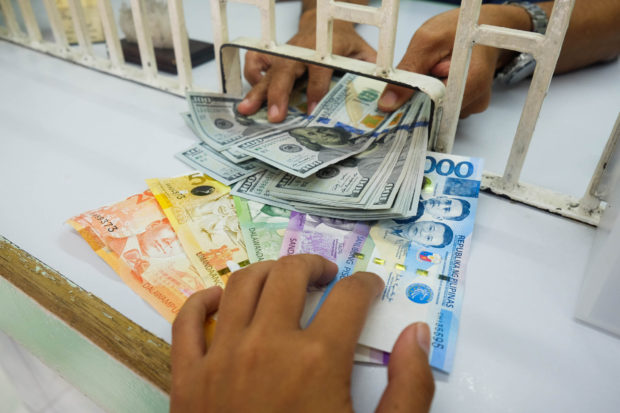The Philippine peso reached another record-low of 59:$1 on Monday after appreciating for three consecutive trading days since closing at 58.99:$1 on Sept. 27.
This is the 12th time that the local currency closed at a new all-time weakest position since hitting 56.77:$1 just a month ago on Sept. 2.
The peso has lost six units to the US dollar while depreciating fast since breaching the 53:$1 threshold last June 10 or barely four months ago.
On Monday, the peso opened at 58.75:$1 and traded best at 58.72 before closing at its worst position during the trading session.
The volume traded shrank to $666.7 million from $1.06 billion the previous trading day or Sept. 30.
Michael Ricafort, chief economist at the Rizal Commercial Banking Corp., said the exchange rate “corrected higher”—the peso depreciated as expected to behave—with tighter reporting requirements for foreign exchange transactions and after continued hawkish signals from United States Federal Reserve officials.
“The peso is also weaker as the markets also anticipate the latest Philippine inflation data that could pick up on Oct. 5,” Ricafort said.
The peso has lost 8.001 to the greenback since closing at 50.999: at the end of 2021.
Ricafort said the continuing weakness of the peso could trigger further interest rate increases by the Monetary Board, which will meet next in November and one last time this year in December.
Nicholas Mapa, senior Philippines economist at Dutch firm ING Bank, said fears about the rapid fire rate hikes from the Fed have pushed both developed and emerging markets to the brink with currencies battered by the strong US dollar.
US Fed chair “Jay Powell has offloaded a series of hawkish moves and rhetoric largely because inflation in the US remains at high levels,” Mapa said.
He said that in the face of such a determined Fed, there appears to be little that developing or emerging markets can do for now as stocks and bonds fall sharply.
“Central banks need to do what central banks need to do for their countries and with the Fed needing to deal with inflation we’ve seen the [US Fed] unflinching in their resolve to get inflation under control [by raising rates aggressively,]” Mapa said. INQ
